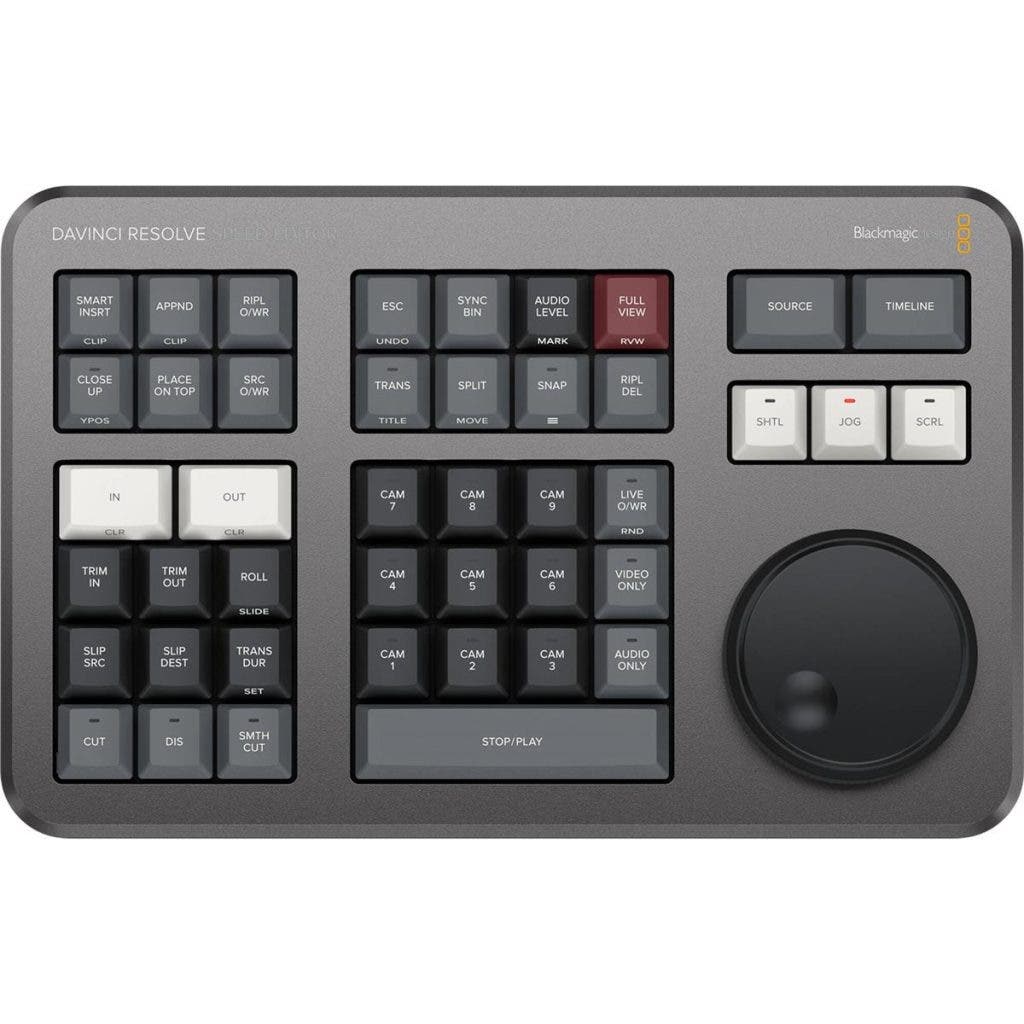Video and audio editing can take much longer than recording the footage. The editors watch and listen to a large volume of video and audio footage, build the narrative, synchronize the scenes, retouch the image and sound, and add effects and subtitles. They gather files in different formats and convert them to a single one, add still images and music if necessary, and make the film cohesive, smooth, and fluid. The viewer knows and feels nothing of the work behind a movie. To produce high-quality movies, video editors need the best tools. They need speed and accuracy and use every trick in the book to achieve that. The DaVinci Resolve Speed Editor by Blackmagic Design is one of the preferred tools for speeding up the editing process.
What is the Blackmagic Design Speed Editor?
Blackmagic Design DaVinci Resolve Speed Editor is one of the two editing keyboards designed by Blackmagic Design to improve editing speed and provide the editor with the best experience while using the DaVinci Resolve software. The DaVinci Resolve Speed Editor is the smaller and more portable of the two models and includes only the specific keys for editing.
However, if you feel the need to use the computer’s keyboard, you can do that in conjunction with the Speed Editor. Because the Speed Editor includes built-in Bluetooth, it connects wirelessly to the computer and allows you to use the computer’s keyboard simultaneously.
Every detail of the DaVinci Resolve Speed Editor syncs with the software. You don’t have to learn to use shortcuts like you do with a regular keyboard. That’s because it has dedicated keys for editing functions, placed in separate groups to maximize your speed. You even get a camera number section to select the camera footage you want to edit, cut from camera to camera, and feel like a production switcher.
In addition, instead of using the mouse to search through the timeline, the Speed Editor provides the Search Dial. This is more comfortable to use, faster, and more accurate. Paired with the dedicated trim buttons, the Search Dial becomes a trim control. So, the Speed Editor is a smart replacement for your keyboard and mouse while editing videos in DaVinci Resolve.

Key Features of the Speed Editor
The Speed Editor provides easy-to-locate-by-feel keys and uses them to address all editing aspects, from scrolling to footage to trimming and arranging scenes in the timeline. Here are its best features.
Search Dial Control
The Search Dial is the dream of any professional video editor. It has a machined metal design, feels heavy and real, and can move with precision and very fast. The Speed Editor uses the Search Dial for moving up and down the timeline and source tape, but also for trimming in conjunction with the trim buttons.
Transport Control
For fast playback control, the Speed Editor provides three dedicated buttons: Shuttle, Jog, and Scroll. The buttons change the function of the Search Dial and allow you to use it for playback. You can switch quickly from one mode to another because the shuttle, jog, and scroll buttons are placed within thumb reach.
Intelligent Keyboard Edit Modes
Edit functions are controlled by a group of keys on the top left of the Speed Editor. They use smart indicators in the timeline, releasing you from placing in and out points. You can use them while browsing through the source tape and don’t waste time going back and forth between the timeline and the source tape. The edit functions keys are Smart Insert, Append to End, Ripple Overwrite, Close Up, Place on Top, and Source Overwrite.
Fast In and Out Point Buttons
Large in and out point buttons, easy to locate, ensure the optimal speed for the most used editing function. They are designed for left-hand use, just below the edit functions keys and above the trimming keys. They also have a different color than the rest of the keyboard, making things even faster.
Bluetooth Connection
The Bluetooth connection provides multiple benefits. First, you can connect the keyboard to your computer without using wires and have a clean and minimalist working desk. Then, you can use the Speed Editor in conjunction with the regular keyboard of your computer and extend your options. Last but not least, a wireless connection means improved portability and ergonomics.
Internal Battery
The Speed Editor features an internal battery that charges via USB-C. If you use the USB port to connect the keyboard to your computer, the internal battery charges while you work. You can then use the wireless Bluetooth connection without worrying about battery life.

Who Should Use the Speed Editor?
DaVinci Resolve is a complete video editing solution for retouches and color corrections, editing, audio post-production, visual effects, and motion graphics. As a result, it is a popular tool among professional video editors, such as independent filmmakers and Hollywood editors. It even provides multi-user collaboration for use in editing studios. Therefore, all DaVinci Resolve users benefit from having a dedicated editing keyboard, specially designed for the software they love.
If you think it’s problematic to use a keyboard that only works with particular video editing software, think again. Once you buy the Speed Editor, you also get the full version of DaVinci Resolve. It means videographers and filmmakers can use the editing software for small productions because they get it for free when buying the Editor.
The Speed Editor is a good choice if you’re looking for speed, efficiency, and portability. If you struggle to edit videos with a regular keyboard and mouse or you reckon it takes too much time, a dedicated small, compact, and focused keyboard will work to your advantage. Almost everything you do in the editing phase can be done a second or two faster with the Speed Editor. This quickly adds up to minutes or even hours on larger productions. Every trim, clip insertion, scrolling through the timeline, or source clips, and switching between multicam clips will get faster with the dedicated keyboard.
How to Get the Most Out of the Speed Editor
The Speed Editor is designed to work in the Cut module of Davinci Resolve. tthis is where it truly shines, and where you will get the most out of it.
Learn the Shortcuts
You’ll see that its group arrangement allows you to locate them by feel and focus on one category of functions at a time. Furthermore, some keys are so intuitive and easy to use that you’ll learn to use the keyboard in no time. They are designed as shortcuts, so read about them and put them to use.
The Speed Editor’s design is simple: the right hand is almost entirely dedicated to controlling the Search Dial, while the left-hand dictates the action. For example, you can use the trim buttons in conjunction with the Search Dial. Press one of the Trim buttons and use the Search Dial to adjust trimming in real time. You won’t get more precision than that.
Search Dial Options
The Search Dial also helps you scroll through the media pool (press the Source button for this particular feature), control playback (use the shuttle, jog, and scroll buttons to change the Search Dial’s function during playback), and apply footage from a particular camera to the timeline (a feature called live override).
In and Out Points
It also helps to learn how to add in and out points fast because the Speed Editor is very good at this and can save you a lot of time. Again, the right hand controls the Search Dial and scrolls through the timeline, and the left-hand presses one of the two large white buttons (called IN and OUT). However, you can make edits without in and out points by using the edit functions. For example, the Smart Insert button inserts a clip in the nearest edit in the timeline without you switching to the timeline and selecting a point.
Learn Every Smart Key
Other keys save you a lot of time, too, such as Ripple Overwrite, which replaces a clip in the timeline with another one and automatically adjusts the space to fit the new clip. Close Up is another smart key. It can create a close-up from the available footage and place it in the timeline, so you can have two camera angles even if you shot only one. These features are extremely helpful and easy to use. So don’t overlook any key on the Speed Editor because there is value to each of them.
Transition Duration Buttons
Transitions are also seamless and facile. For example, you have a Transition Duration button that allows you to set the duration of a transition by rotating the Search Dial. If you prefer to use the default transition duration, just double-press the Transition Duration button and it will set it for you. The Speed Editor has another three dedicated buttons for transitions: Cut (removes all effects on the current edit point), Dissolve (adds a dissolve to the current edit point), and Smooth Cut (adds a smooth cut instead of a jump cut).
When you are comfortable with the most common features of the keyboard, the next step is to master the sub-functions assigned to a lot of the buttons. They work by double-clicking or click-holding down the keys while using the search dial.
Conclusion
The Speed Editor is an amazing tool to use when you spend long hours editing videos and movies with DaVinci Resolve. It helps you make the most out of the software and enjoy the editing process. You don’t have to learn shortcuts or struggle to produce accurate edits with a mouse. Instead, you have dedicated buttons for everything you need and a reliable and sturdy Search Dial for precision. As we’ve seen, the Speed Editor features combine to produce a pleasant experience and effective workflow. And if you take the time to learn the functions of its keys, you can forget about the keyboard and focus all your attention on creativity and narrative.






